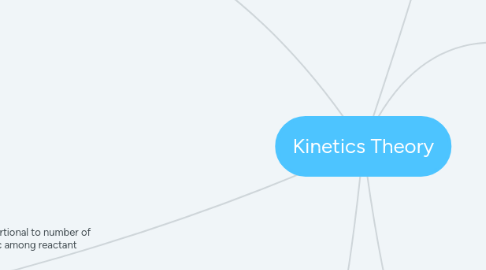
1. Without this minimum amount, reaction will not occur even when correctly oriented
2. Kinetic molecular gas theory
2.1. A gas particles was considered as a hard sphere.
2.2. A gas consist of an extremely large number of tiny particles that are in random motion
2.3. The gas particles occupy a net volume that so small as compared to the volume of container that their contribution to the total volume can be ignored
2.4. The particles collide elastically with them self and the walls of the container.
2.5. The particles neither attracting nor repelling each other.
2.6. The energy can be transfer among the particle but the kinetic energy of particle remain constant.
2.7. The collision time is too small as compare to the time between collision.
3. Collision theory
3.1. Rate of reaction proportional to number of effective collisions/sec among reactant molecules
3.2. 1. Reaction rate depends on [reactants] and T 2. Based on Kinetic Molecular Theory 3. Accounts for both effects on molecular level Central Idea 4. Molecules must collide to react 5. Greater number of collision/sec = greater reaction rate
3.3. Effective collision 1 that gives rise to product depends on 3 criteria i. Molecular orientation ii. Temperature iii. Activation energy
3.3.1. 1. Molecular Orientation Molecules must be oriented in a certain way during collisions for reaction to occur
3.3.2. 2. Temperature Greatly Affects Rates
3.3.3. 3. Activation Energy, Ea Molecules must possess certain amount of kinetic energy (KE) in order to react
3.3.3.1. Minimum KE needed for reaction to occur
3.3.3.2. Get energy from collision with other molecules
3.3.3.3. Upon collision, KE converted to potential energy (PE), used to stretch, bend, and break bonds leading to chemical reaction
3.3.3.4. If molecules move too slowly, too little KE, they just bounce off each other
3.3.3.5. Major reason all collisions do not lead to reaction
4. Transition state theory
4.1. Used to explain details of reactions What happens when reactant molecules collide
4.2. Potential Energy Diagram To visualize what actually happens during successful collision Relationship between Ea and developing Total PE
4.2.1. Endothermic Reaction
4.2.2. Exothermic Reaction
4.3. H# is the enthalpy difference between the activated complex and the reactants A and B. It is called activation enthalpy S is for the entropy, the extent of randomness or disorder in a system. The entropy difference between activated complex and the reactants is called activation entropy S#. S# can be determined and thus is enabled the calculation of G# for the appropriate reaction temperatures A stabilization of the activated complex reduces the enthalpy difference G# and increases the rate. G# represents the determining driving power for a reaction. T he sign of G# determines if a reaction is spontaneous or not
4.3.1. lnkT = −ΔH†R1T + lnkBh + ΔS‡R
5. Arrhenius theory (The Arrhenius equation is founded on the empirical observation, that raising the temperature increases the rate of reaction)
5.1. k = Aexp(−E/RT)
5.1.1. Ea = activation energy
5.1.2. R = 8.314 J mol-1K-1
5.1.3. T = absolute temperature in Kelvin
5.1.4. A = frequency factor/Arrhenius constant/ pre-exponential factor
5.2. lnk= lnA+ (− E a/RT)
5.2.1. A plot of ln k versus 1/T produces a straight line, from which the activation energy, Ea, can be determined because the slope is equal to - Ea/ R.
5.2.2. Plot of ln k vs 1/T
5.2.3. Yields straight line slope = Ea/R intercept = A
